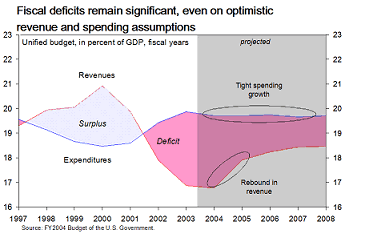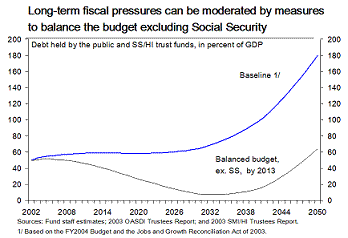2003 Article IV Consultation with the United States of America Statement of the Fund Mission
June 16, 2003
June 16, 2003
Overall assessment
1. The U.S. economy has continued to provide valuable support for global growth, despite being hit by substantial shocks in recent years. Following the bursting of the stock market bubble in 2000, the economy was further shaken by the September 11 attacks, corporate failures, and spillovers from geopolitical uncertainties. Nonetheless, the remarkable resilience and flexibility of the U.S. economy and financial system, as well as the exceptional stimulus provided by monetary and fiscal policies, helped make the 2001 downturn relatively short and shallow. Productivity growth has remained robust, and final domestic demand has begun to recover.
2. However, the recovery has been uneven, and short-term prospects remain uncertain. We expect growth to rise above its potential rate in the latter half of 2003 and into 2004, with the relatively quick resolution of the Iraq war, lower oil prices, and continued support from monetary and fiscal policies. Even so, it remains to be seen whether the adjustments associated with the unwinding of the equity price bubble have fully run their course, and downside risks remain a concern given the continued weakness of industrial activity and employment conditions.
3. Medium-term growth prospects generally appear favorable, but recent tax cuts heighten concern regarding the long-term fiscal problem. To be sure, fiscal policies have provided valuable support to the recovery so far, but the tax package leaves the fiscal position even less prepared to cope with the retirement of the baby-boom generation later this decade. Sustained fiscal deficits would eventually crowd out investment and erode U.S. productivity growth. They would also tend to boost the already large U.S. current account deficit, imposing a further drain on global saving and increasing the risk of disorderly exchange market conditions.  4. Against this background, the challenge is to manage short-term risks to the outlook, while establishing a credible approach to coping with longer-term fiscal pressures. In the IMF staff's view, responding effectively to this challenge will help promote growth as well as domestic and external sustainability, in line with the G7 finance ministers' commitment to cooperate to promote global economic growth.
Monetary policy and the exchange rate 5. While monetary policy has responded aggressively to the economic slowdown, further easing may still be required if the recovery does not regain momentum. With inflation having fallen to near post-war lows and interest rates close to the zero bound, the appropriate bias is toward aggressive and preemptive action to support a healthy recovery. Although deflation risks in the United States appear modest, the FOMC's strong signal of its readiness to act, and its willingness to use a broader range of policy instruments should deflationary pressures intensify, is welcome. 6. A quantified statement of the Federal Reserve's longer-term inflation objective would further anchor inflation expectations and help guard against deflation risks. Aiming for an inflation rate in the range of 2 percent would still leave room for countercyclical policy responses consistent with the Federal Reserve's dual mandate to achieve price stability and full employment. Making this objective explicit would seem especially helpful now that interest rates have moved close to zero and deflation is a concern. 7. The dollar's recent weakness has added to uncertainty and may pose challenges for short-term macroeconomic policy management among partner countries. The authorities have correctly emphasized that exchange rates have responded to market forces and that foreign exchange market intervention has little enduring influence. Indeed, the dollar's depreciation represents a step toward bringing the U.S. current account deficit to a more sustainable position. However, an abrupt weakening of investor sentiment and turbulent exchange market conditions would have adverse consequences both domestically and abroad. A firm commitment to reducing the U.S. fiscal deficit over the medium term, as well as strong growth among partner countries, would help ensure that the eventual adjustment of the U.S. current account deficit is orderly and rests on a strengthening of national saving rather than weaker U.S. investment and growth.  Fiscal policies 8. The priority for fiscal policy should be to establish a credible framework for returning the budget to balance, excluding Social Security, over the medium term and to place retirement and health care systems on a sound financial footing. Although the deficit/GDP ratio is projected to narrow somewhat in coming years, these projections are based on assumptions—including a sharp improvement in tax receipts and strict limits on discretionary outlays, excluding defense and homeland security—that may prove optimistic, especially since supporting policies to ensure strict limits on discretionary spending have yet to be defined. Moreover, the retirement of the baby-boom generation will place increasing pressure on the Social Security and Medicare systems in coming decades, potentially causing debt and deficits to rise rapidly. The unfunded actuarial liability of these programs is estimated at around 180 percent of GDP if measured over a 75-year horizon and even higher if measured over longer periods. Balancing the budget, excluding Social Security, over the next five to ten years would enable a substantial reduction in the debt ratio ahead of this demographic shift and provide greater room to implement the needed reform of entitlement programs. 

9. Tax and expenditure policies will need to be geared toward ensuring a sustainable fiscal position. In this context, the recent tax package has added to uncertainty about the future paths of tax rates and—as recently illustrated in a study by the Congressional Budget Office—is unlikely to boost output in a sustained manner unless its adverse budgetary impact is offset over the medium term. Meeting the fiscal costs of population aging will eventually require revenue increases—preferably through base broadening measures that focus on eliminating corporate and personal income tax preferences—and sustained spending restraints. 10. The Budget Enforcement Act (BEA) disciplines could provide a credible framework for ensuring that these medium-term trade-offs are faced squarely and that policies are consistent with fiscal sustainability. The federal budget is highly transparent and represents best practice in many areas, but recent developments have raised questions about the adequacy of fiscal discipline. In addition to the sharp increase in discretionary spending that has occurred, recent tax cuts have been phased-in and subjected to sunsets in a manner that leaves their longer-term budgetary consequences unclear. The caps on discretionary outlays and pay-as-you-go requirements applied under the BEA contributed to the successful fiscal consolidation during the 1990s. If restored and strengthened further, these disciplines could usefully support the fiscal adjustment that is needed in the period ahead, particularly if accompanied by broader efforts to re-establish a political consensus for budget balance. 11. Steps also should be initiated soon to strengthen the financial position of the Social Security and Medicare systems. In the case of the Social Security system, relatively modest changes in the system—including amendments to indexation formulas, increases in the retirement age, or hikes in contributions rates—would be sufficient to close projected shortfalls. However, these measures take considerable time to phase-in, and larger and more painful adjustments will be required the longer decisions are delayed. The financial position of the Medicare system is considerably worse, given the rapid growth of health care costs and the modest share of benefits that are covered by individual contributions. In these circumstances, any measures to enrich benefits, including for prescription drugs, should be accompanied by credible measures to address the system's longer-term financial problems. 12. Energy policies that operate on the demand-side—as well as the supply-side—would help support both environmental and fiscal objectives. Current proposals embodied in the Energy Bill aim to boost U.S. energy production and reduce emissions intensity, principally through tax and other incentives for businesses. Measures that directly target consumers—including energy-related taxes—also could be effective in aligning energy demand and supply and achieving emissions goals, while contributing to longer-term budgetary objectives. 13. Fiscal pressures at the state and local government levels are a growing concern. Recent federal initiatives have devolved greater responsibility and accountability for programs to the states, including by shifting funding for programs from a cost-sharing to a block grant basis. Although this approach has merit, the burden on states—including for welfare, education initiatives, and homeland security—has increased at a time when state revenues have been severely affected by the economic slowdown. Proposed reforms to Medicaid funding will need to take into account the growing pressures on the system from population aging and spillovers from the Medicare system. Financial sector and corporate governance 14. Financial sector balance sheets have held up well, and corporate profitability seems to be recovering. However, care will be needed to ensure that banks are well-positioned to absorb the effect on balance sheets of an eventual turnaround in interest rates or a possible cooling of conditions in the real estate market. The rapid growth and systemic importance of Fannie Mae and Freddie Mac suggest the possible need for measures to further limit these agencies' special status, especially in view of the implicit government guarantee that markets attach to their liabilities. 15. Considerable progress has been made toward strengthening the oversight of accounting and corporate governance. The remaining challenge is to ensure that the responsible agencies are provided with the resources and the support to complete the reform agenda. Key tasks will be to improve the accounting of stock options; ensure the independence of corporate boards; and achieve greater harmony between U.S. and international accounting standards. In addition, the significant underfunding of defined-benefit corporate pension plans that has emerged in recent years points to the need to strengthen the accounting and transparency of these plans, as well as the finances of the Pension Benefit Guaranty Corporation. Trade policies and development assistance 16. The United States will need to continue to play an important leadership role in promoting trade liberalization. A more open and liberal trade system has enormous potential for fostering growth in all countries, and the United States has already made helpful proposals for moving the Doha Round forward. As it is essential to reinvigorate the momentum toward a successful completion of the Round, it will be important for the United States to find common ground with partner countries in a range of difficult areas, such as the public health exemption on TRIPs. The authorities are also encouraged to take early action to comply with recent WTO rulings. Ongoing negotiations of bilateral and regional free-trade agreements have the potential to bring substantial benefits to the partner countries involved. In this context, it will be important to ensure that such initiatives complement, rather than substitute for, broader multilateral efforts toward liberalization and that they are designed to limit trade diversion and administrative complexities. 17. There are also important opportunities to better align U.S. trade and other domestic policies with the broader commitment to development. Recent efforts to improve access to U.S. markets for countries in Africa and the Andean region, and to boost overseas development assistance (ODA)—including in the context of the Millennium Challenge Account, are welcome. However, U.S. development assistance as a share of GNP would still remain among the lowest among the industrial countries, and larger increases in foreign assistance would still be desirable. There also remains scope for improving the complementarities between development and trade policies, including by reducing subsidies to U.S. agricultural producers and by more ambitious efforts to eliminate remaining non-tariff barriers to imports from developing countries. |
IMF EXTERNAL RELATIONS DEPARTMENT
| Public Affairs | Media Relations | |||
|---|---|---|---|---|
| E-mail: | publicaffairs@imf.org | E-mail: | media@imf.org | |
| Fax: | 202-623-6278 | Phone: | 202-623-7100 | |


